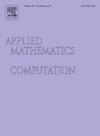采用组合质量的运动域流行病模型的数值解
IF 3.4
2区 数学
Q1 MATHEMATICS, APPLIED
引用次数: 0
摘要
描述了基于质量守恒的移动网格有限差分法在流行病模型中的应用,将交叉扩散和自扩散相结合,以表示社会距离和自我隔离。该模型的一个重要特征是移动边界,它描述了疾病在该领域的传播。数值说明强调了社会互动对传播和感染率的影响。值得注意的是,模拟显示,尽管生殖参数很高,但疾病在很小的初始感染半径内传播得到了遏制。结果证实了移动网格方法在多种群系统流行病模型中的有效性。本文章由计算机程序翻译,如有差异,请以英文原文为准。
The numerical solution of epidemic models on moving domains using combined masses
The application of a moving mesh finite difference method, based on mass conservation, is described for epidemic models, integrating cross- and self-diffusion to represent social distancing and self-isolation. A significant feature of the models is the moving boundary which describes the spread of the disease in the domain. Numerical illustrations emphasise the influence of social interactions on transmission and infection rates. Notably, simulations show containment of disease spread within a small initial infected radius despite a high reproductive parameter. The results affirm the efficacy of the moving mesh approach for multi-population systems in epidemic models.
求助全文
通过发布文献求助,成功后即可免费获取论文全文。
去求助
来源期刊
CiteScore
7.90
自引率
10.00%
发文量
755
审稿时长
36 days
期刊介绍:
Applied Mathematics and Computation addresses work at the interface between applied mathematics, numerical computation, and applications of systems – oriented ideas to the physical, biological, social, and behavioral sciences, and emphasizes papers of a computational nature focusing on new algorithms, their analysis and numerical results.
In addition to presenting research papers, Applied Mathematics and Computation publishes review articles and single–topics issues.

 求助内容:
求助内容: 应助结果提醒方式:
应助结果提醒方式:


